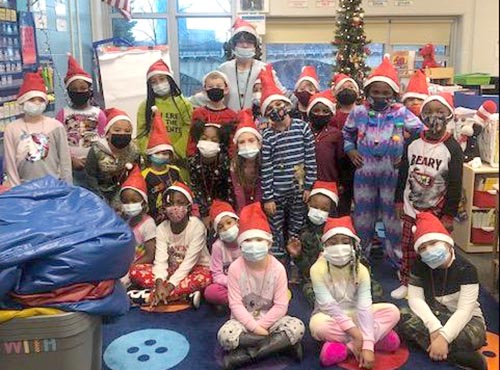
Providing fun, engaging activities and welcoming settings for instruction can boost happiness in classrooms — and learning.
From K-12 Dive
By Kara Arundel
Dec. 20, 2021
Maura Renzi could teach her 1st graders about the stages of the moon by showing them graphics of the monthly solar changes and having the students make pencil shadings on a worksheet.
But instead, she hands out Oreo cookies and encourages students to take the sandwich cookies apart and eat away at the white cream centers until they resemble the eight lunar phases. The class also built moon mobiles and wrote books about the moon.
“I just feel like learning needs to be fun,” said Renzi, who teaches at Edison School of the Arts in Indianapolis Public Schools. “Anytime that they’re having fun, they’re more engaged.”
Across the country, educators like Renzi are infusing joy and happiness into learning. It’s a strategy that has been recommended — and executed — for many decades, but one teachers and administrators say has become more deliberate and purposeful since COVID-19 disrupted in-person learning and created economic, emotional and physical hardships for communities and families.
“I think folks are trying to bring joy to classrooms and schools in general by making it a place where kids want to be,” said Robert Simmons, a scholar in residence at American University’s School of Education and a former teacher and administrator. “People are trying to make sure that they engage kids and [have] activities that are actually fun.”
Here, educators, researchers and advocates share their recommendations of how learning can be both rigorous and joyful:
Provide a welcoming place to learn
Making learning spaces aesthetically attractive boosts the desire for learning. Renzi transforms her classroom into a magical and whimsical place to encourage learning. For example, in March she tells her students a leprechaun has been following her family, and she’ll decorate the classroom with green glitter.
When students come to the classroom each morning, they see leprechaun footprints marked in “fairy dust.” Then on March 17, students discover leprechauns “visited” overnight and have tipped over chairs and caused good-natured chaos.
The mythical creatures also leave chocolate coins and dollar bills for students. Although the St. Patrick’s Day fun is not connected to a specific lesson, students practice their literacy and writing skills by reading books about the holiday and writing about what they would say to a leprechaun if they met one.
“It’s just something fun to let them imagine,” Renzi said.
Connect with communities
Having trust and transparency with community organizations can strengthen school-home-community relationships, which benefits the entire school community, said Simmons.
“It’s not just about educating kids inside of the building, but it’s also about supporting and educating kids and embracing their humanity on the outside, right?” Simmons said.
Through collaboration, schools and community partners can help prevent certain neighborhood challenges from interrupting students’ educational pursuits.
For example, Washington, D.C., Mayor Muriel Bowser recently announced the city is supporting a new safety initiative that places trusted and caring adults along routes to support students as they walk to and from schools. The Safe Passage Safe Blocks program will receive $4.3 million from the D.C. Office of Out of School Time Grants and Youth Outcomes for FY 2022.
Community-school collaborations can also address food insecurity, another big barrier to learning, Simmons said. Creative enterprises such as community gardens can not only provide nutritious food, but allow for instruction in horticulture — as well as build school spirit.
“I don’t think that as a K-12 system, we spend enough time thinking about hydroponic gardens, and like how do you grow food as a communal enterprise with the school being the hub,” Simmons said.
Incorporate games, project-based learning
Staying relevant to students’ interests and incorporating some of those elements into instruction can get students excited for learning, said Laura Tierney, founder and CEO of The Social Institute, an online learning platform.
For instance, some teachers create short videos of lessons to post on social media platforms popular with students.
Teachers also gamify lessons to make learning fun. Trivia-type apps, such as Kahoot and Quizlet, let teachers customize games for specific lessons.
Instructional games can also be nondigital, according to Michele Haiken, an English teacher at Rye Middle School in Rye, New York. For instance, a scavenger hunt, bingo and dice games can supplement instruction, Haiken wrote in a blog for the International Society for Technology in Education in February.
Tulsa Public Schools in Oklahoma makes learning joyful by using project-based learning and active classrooms during the school day, before and after school, and in the summer, said Superintendent Deborah Gist. The district provides experiential learning not only on its own campuses but at the city’s museums, libraries, zoo and more locations, she said.
“Our students want to have what they’re learning be connected to something real and tangible,” she said.
Photo: Maura Renzi’s 1st grade class at Edison School of the Arts in Indianapolis. Permission granted by Maura Renzi
Read this and other stories at K-12 Dive

